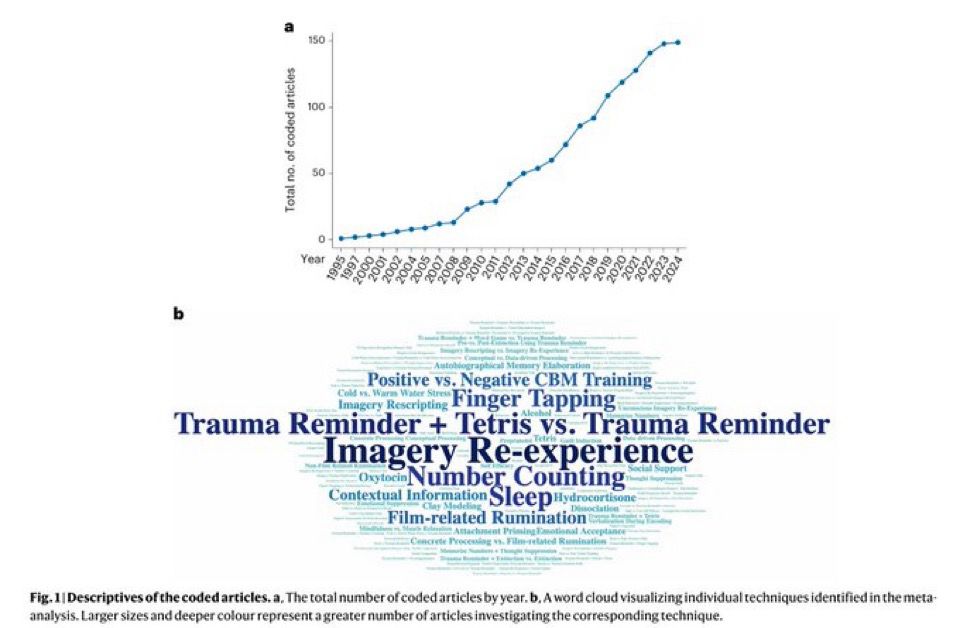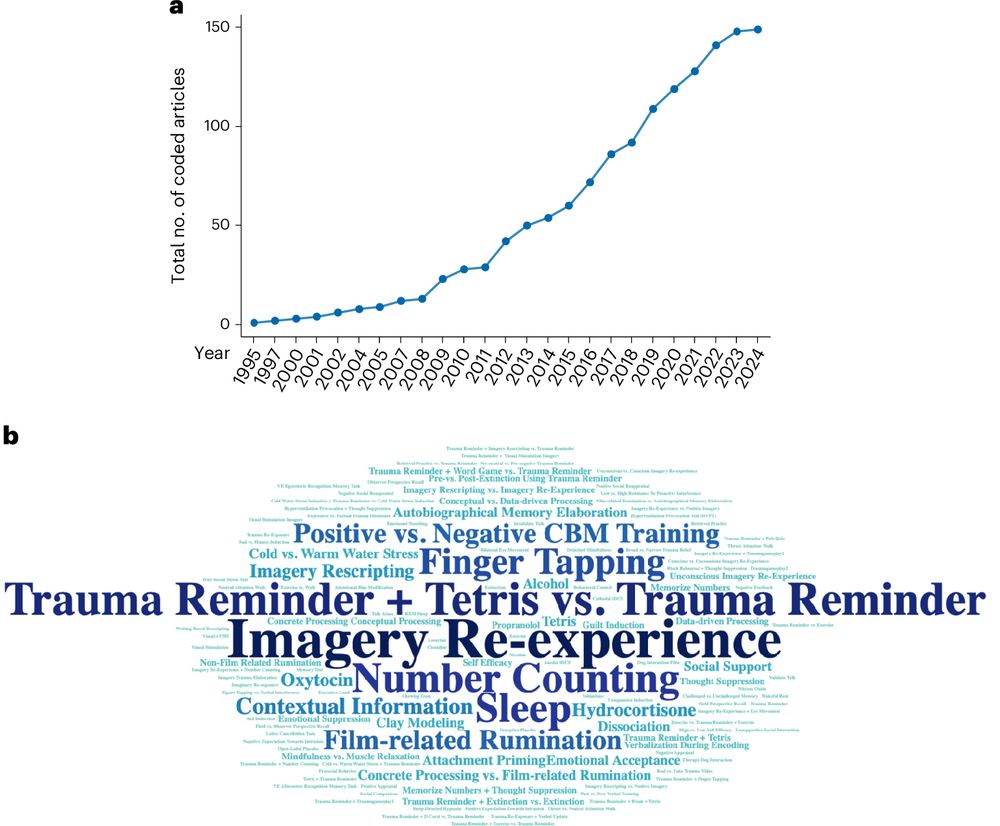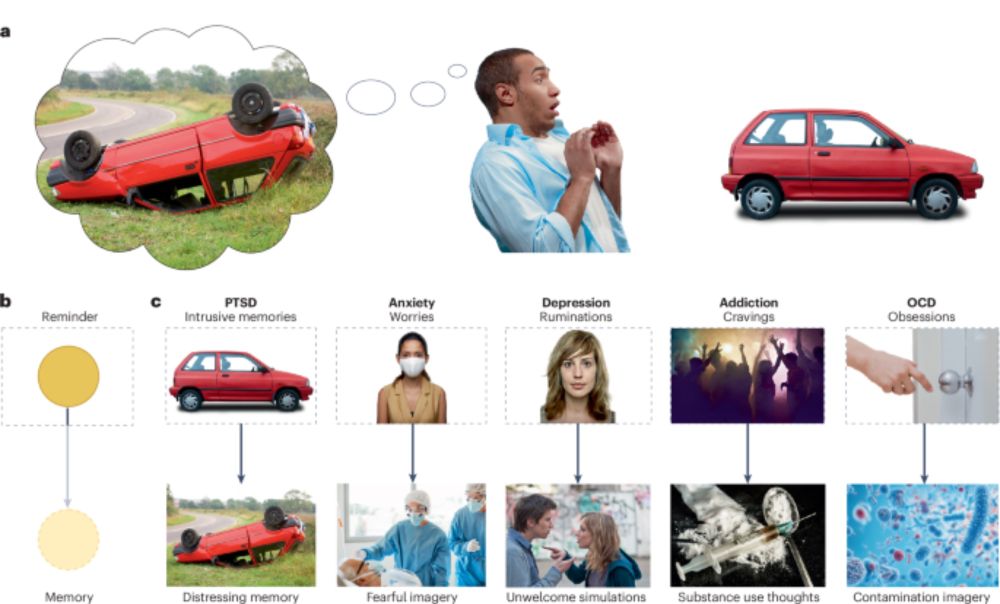🧵8/8
Special thanks to our reviewers, Kirsi Peltonen and Sarah Schäfer, and the editorial team at @nathumbehav.nature.com for their rigorous review, which helped significantly enhance the quality of our work :)
24.05.2025 06:31 — 👍 2 🔁 0 💬 0 📌 0
🧵7/8
Massive thanks to an awesome team of collaborators, namely, co-first author Shengzi Zeng, Laura Singh, Emily A. Holmes, Jingyun Huang, Man Hey Chiu, and Xiaoqing Hu for their contributions to this project!
24.05.2025 06:30 — 👍 1 🔁 0 💬 1 📌 0
🧵6/8
Complementing our study, we have created an interactive website with tools for in-depth exploration of our rich dataset, encouraging further research in trauma memory modulation:
intrusivememory.shinyapps.io/shinymeta/
24.05.2025 06:29 — 👍 0 🔁 0 💬 1 📌 0
🧵5/8
This framework, while preliminary, is a first step towards a deeper understanding of the underlying processes for techniques like Trauma Reminder + Tetris gameplay that show promise in reducing trauma intrusions both immediately and at delayed timepoint after trauma.
24.05.2025 06:29 — 👍 0 🔁 0 💬 1 📌 0

🧵4/8
To grasp the HOW, we developed a categorization system based on each technique’s procedures and hypothesized mechanism.
To probe the WHEN, we split the techniques based on their time of administration and examined their effect sizes within each timepoint.
24.05.2025 06:28 — 👍 0 🔁 0 💬 1 📌 0
🧵3/8
Our work is guided by 2 pivotal questions:
HOW these techniques work?
WHEN are they effective?
Insights from these Qs are crucial for both basic science and translational research into development of effective therapeutic interventions for trauma symptoms.
24.05.2025 06:28 — 👍 0 🔁 0 💬 1 📌 0

🧵2/8
Synthesizing data across 134 articles covering 131 techniques on trauma intrusion modulation, spanning ~30 years of research, we assess how these techniques alter (i.e. increase or decrease) intrusions and associated outcomes, namely intrusion-related distress and symptoms.
24.05.2025 06:27 — 👍 0 🔁 0 💬 1 📌 0
Assistant professor at NYU.
The Centre for Research Informatics Training of the School of Biological Sciences organises high-quality, hands-on training courses in bioinformatics and computational biology, targeting all audiences, from undergraduate to postgraduate level and beyond.
Research, news, and commentary from Nature, the international science journal. For daily science news, get Nature Briefing: https://go.nature.com/get-Nature-Briefing
A Nature Portfolio journal bringing you research and commentary on all aspects of human behaviour.
https://www.nature.com/nathumbehav/
Postdoc at U. of Arizona. Creative Cognition, Spontaneous Thoughts, Dynamic Modelling, EEG & fMRI
Computational neuroscientist interested in cognition, computation, memory, decision making. Studying the human brain.
PhD student with the Prediction and Learning Lab, Cambridge. Working on uncertainty, attention, learning, and possibly anxiety.
The 4D Lab is a research group in developmental cognitive neuroscience based at the Department of Psychiatry and the MRC Cognition and Brain Sciences Unit, University of Cambridge.
https://www.astlelab.com/
Clinical Psychology Postdoc at the MRC Cognition and Brain Sciences Unit, University of Cambridge. Studying empathy, mental health, and transdiagnostic characteristics of psychopathology. #rstats enthusiast. Curious about most things 😊
Cognitive neuroscientist at University of Cambridge. Attention, cognitive control, neurostimulation, neuroimaging.
Cognitive neuroscientist at University of Toronto.
www.leemtllab.com
A modern Cambridge College for a changing world.
homerton.cam.ac.uk
PhD in Cognitive Neuroscience, @MRC-CBU, Uni Cambridge | Gates Cambridge Scholar | Cognitive Control, Attention & Functional Brain Networks | MEG/EEG, fMRI, TMS+ | Incoming CIHR Postdoc Fellow at the MNI, McGill
Cognitive neuroscientist with many interests, including why our stomachs churn when we feel disgust. I also write books on programming; teach Python, statistics, and machine learning; and develop open-source software.
https://www.dalmaijer.org
Prof Psychology, Royal Holloway University of London, Memory, Credibility, Eyewitnesses, Emotion & Law are some of my topics.
Outside work, I seek the sea, a mountain top, a sampling of wine, a good book!
Established in 1992, the Center for Neuroscience is the interdisciplinary hub for neuroscience research and training at UC Davis. https://linktr.ee/UCDavisCenterforNeuroscience
Post-Doctoral Researcher at UCSD studying voluntary memory control. For all my science: https://josephmsaito.github.io/
Assistant Professor at Leiden University, the Netherlands. Interested in novelty, memory and attention.
assistant professor at Boston University | learning, memory, development | cldlab.org
Professor @ CU Boulder. 🇯🇵 Self-regulation of thought, behavior, & motivation (e.g., procrastination, self-control, mind-wandering, repetitive negative thinking, habits). Improving student learning. 1st-gen. A proud cat daddy🐱 Go Seattle Mariners 🔱



